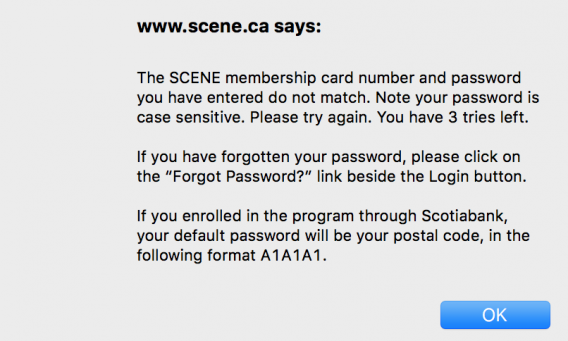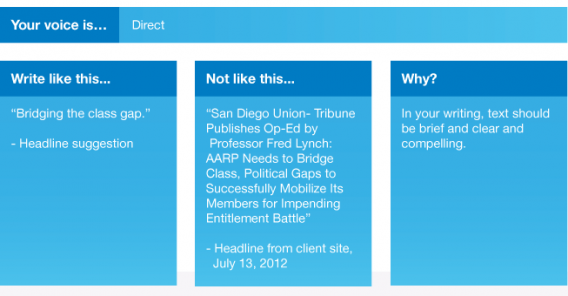You’re likely familiar with the finding that over half of communication is non-verbal.
So perhaps you won’t be surprised to learn that your copy is “saying” a lot more than you think it is. That’s because tone of voice is at play, influencing how visitors read your copy and relate to your company.
Fortunately, tone of voice can be deliberately created, managed and optimized.
Table of contents
What’s the Definition and Use?
Robert Mills of GatherContent offers an excellent explanation…

Robert Mills, GatherContent:
“Tone of voice isn’t what we say but how we say it. It’s the language we use, the way we construct sentences, the sound of our words and the personality we communicate.
It is to writing what logo, color and typeface are to branding.” (via Smashing Magazine)
Essentially, tone of voice can be optimized to…
- Express your personality, make you more personable and likable.
- Set you apart from the competition.
- Persuade your visitors.
You’ve likely read about tone of voice in a content marketing or social media context. (Or maybe in an undergrad English literature class.) But because tone of voice is so deeply rooted in likability (and thus, persuasion), it’s important to put it into an optimization context.
How Can It Be Used Online?
Does everyone need to optimize their tone? No. If you have a product or service that people are required to partake in, you can skip optimizing tone. But if your visitors have a choice to make, which is typically the case, you should be conscious of tone.
Kate Meyer of Nielsen Norman Group studied a long list of literary tone words to eventually narrow in one four dimensions of tone: funny vs. serious, formal vs. casual, respectful vs. irreverent, and enthusiastic vs. matter-of-fact.
What I like about this model is that it’s not binary. Your site doesn’t need to be exclusively funny, casual, irreverent and enthusiastic. It can fall somewhere in the middle vs. being lumped into one of two extremes. The dimensions simply make auditing and guidelines easier for optimizers.
1. Funny vs. Serious
Here’s an excerpt from Cards Against Humanity‘s about blurb…
Cards Against Humanity is a party game for horrible people. Unlike most of the party games you’ve played before, Cards Against Humanity is as despicable and awkward as you and your friends.
The game is simple. Each round, one player asks a question from a black card, and everyone else answers with their funniest white card.
Now, compare that to PayPal‘s more serious about blurb…
At PayPal (Nasdaq:PYPL), we put people at the center of everything we do. Founded in 1998, we continue to be at the forefront of the digital payments revolution. In 2015, 28% of the 4.9 billion payments we processed were made on a mobile device. PayPal gives people better ways to connect to their money and to each other, helping them safely access and move their money and offering a choice of how they would like to pay or be paid.
2. Formal vs. Casual
Here’s an excerpt from Harvard University‘s about blurb…
Harvard University is devoted to excellence in teaching, learning, and research, and to developing leaders in many disciplines who make a difference globally. The University, which is based in Cambridge and Boston, Massachusetts, has an enrollment of over 20,000 degree candidates, including undergraduate, graduate, and professional students. Harvard has more than 360,000 alumni around the world.
And here’s a contrastingly casual about blurb from Innocent Drinks…
hello, we’re innocent
…and we’re here to make it easy for people to do themselves some good (whilst making it taste nice too).
We started innocent in 1999 after selling our smoothies at a music festival. We put up a big sign asking people if they thought we should give up our jobs to make smoothies, and put a bin saying ‘Yes’ and a bin saying ‘No” in front of the stall. Then we got people to vote with their empties. At the end of the weekend, the ‘Yes’ bin was full, so we resigned from our jobs the next day and got cracking.
Since then we’ve started making coconut water, juice and kids’ stuff, in our quest to make natural, delicious, healthy drinks that help people live well and die old.
3. Respectful vs. Irreverent
Here’s MailChimp preparing me for my “moment of glory” as I’m getting ready to send an email campaign…

And here’s Reigns criticizing my ability to run a kingdom…

Note that the above example is an exception to a common rule. Typically, when the tone is irreverent, the subject is the victim. In this case, Reigns is intentionally irreverent to the reader.
4. Enthusiastic vs. Matter-of-Fact
Here’s an enthusiastic error message from Slack…

And here’s a more dry, matter-of-fact error message from Scene…

Above all, just don’t be boring.
No one is engaged by boring, even in a boring industry. The people making the decisions are still, well, people. Joanna Wiebe of Copy Hackers and Airstory explains…

Joanna Wiebe, Copy Hackers & Airstory:
“B2B copy is particularly guilty of being boring to read… because there’s this misconception that businesses, lawyers, accountants, etc only wish to be informed. As if they are robots. As if they have no emotion, don’t smile at puppies, don’t watch movies, wear uniforms and live in a plain white box.” (via Copy Hackers)
Harriet Cummings, freelance writer, believes that any tone can be transformed from boring to engaging. All it takes is a bit of reworking…

Harriet Cummings, Freelance Writer:
“Make a list of common phrases you use to describe your product or service. Then reinvent these in alternative ways. e.g.:
- We sell a range of state-of-the-art printers.
- We sell printers pimped out with all sorts of gadgets and buttons.
- We’ve discovered a range of printers sent from the future.
- Printers so advanced, they know what to print before you even write it.” (via Distilled)
How to Define Your Tone of Voice
Of course, for optimizers, the job doesn’t stop with a little “reworking”. You want to make data-driven decisions about how to engage your audience and use tone to persuade them.
In order to do that, you’ll need to focus on two things: your brand’s personality and your visitors’ personalities.
1. Your brand’s personality.
Start by getting to the root of your company’s culture. You can gather a lot of insight by interviewing stakeholders, especially founders.
Here are some talking points you can use, as suggested by Chase Roberts…
- If your brand was a person, what kind of personality would it have?
- If your brand was a person, what’s their relationship to the consumer? (A coach, friend, teacher, dad, etc.)
- Describe in adjectives what your company’s personality is not.
- Are there any companies that have a similar personality to ours? Why are they similar?
This exercise is about understanding how the key stakeholders would (and would not) describe the brand’s personality.
However, be aware that smart optimizers are not merely using tone to convey (or create) personality. Personality is a nice-to-have, but doesn’t inherently have anything to do with conversions or revenue.
Joanna explains how to shift your thinking to really get value out of tone…

Joanna Wiebe, Copy Hackers & Airstory:
“Now, you may be sold on the idea of cultivating a better tone. And, from there, you may come to believe that your tone should reflect your personality – but, IMHO, creating a personality shouldn’t be your primary objective in developing your tone. Rather, you should develop a tone in order to:
- Enact the value your visitors desire, such as dependability or entertainment
- Engage your visitors by making your site copy more enjoyable to read (i.e., less like work)
- Stimulate positive feelings that then become associated with your brand
With those points in mind – rather than simply ‘creating a personality’ – you can see that real business goals can be directly tied to the development of an excellent tone.” (via Copy Hackers)
So, yes, get to the root of your culture and brand personality. But don’t get too caught up in it.
2. Your visitors’ personalities.
Equally important is how your brand personality matches up with your visitors’ personalities. Vague advice like “be authentic” is nice, but what if your authentic brand personality is entirely unappealing to those you’re trying to sell to?
Try to remember that you’re creating a personality for the brand, not simply extending your own personality (or even your CEO’s personality). That created personality is what you must be authentic to.
In creating that personality, you want to ensure it appeals to your ideal customer profile. After all, you lose the likability factor if the brand personality is not, well, likable. To do this, you’ll need to fully understand your audience.
Ask yourself these questions…
- Who is my ideal customer?
- What’s her job title? What type of company does she work for? What industry is she in?
- What sites does she visit in her spare time?
- What does she do outside of work?
- What words does she use? Does she swear? Does she respond well to humor?
- What values does she hold? Beliefs?
- How does she like to be praised? Criticized?
The list goes on. The idea is to fully understand your visitors’ personalities before proceeding. You can achieve this through customer interviews and other forms of market research.
Group learnings to: create data-driven personality personas or identify 3-4 key characteristics.
How to Apply This Concept
Once you have an understanding of how your brand’s key stakeholders see the brand’s personality and the personalities of your visitors, you can start the tone of voice optimization process.
1. Establish an ideal tone of voice based on business objectives.
As Joanna mentioned, tone of voice can be tied to legitimate business goals. Tone of voice can be used to…
- Demonstrate the value you’re trying to persuade visitors to buy.
- Create an engaging experience so visitors actually enjoy reading your copy.
- Create positive emotions, which then become mentally associated with your brand.
What’s important is that you’re deliberate about connecting tone of voice to business goals from the beginning. As Kevan Gilbert of Domain7 explains, most people fall into their tone of voice without much logical thought…

Kevan Gilbert, Domain7:
“We often end up stumbling into the voice our companies use on the web, accidentally. It doesn’t have to be this way, especially when we’re talking about an asset as powerful as your words.
There is an opportunity to influence the reactions and emotions of your customers in a manner that is natural and healthy: why not aim to gain control of your organization’s tone of voice?” (via GatherContent)
Don’t forget to also focus on how you can create the tone of voice / personality that best speaks to your data-driven personality personas or 3-4 key characteristics, which you discovered above. Everything depends on this.
For example, the tone of voice you use to demonstrate the value you’re trying to persuade visitors to buy will depend on your personality personas / key characteristics.
2. Conduct conversion research to understand how customers currently feel.
You should now have an idea of the tone of voice you’ll need to achieve your business goals and speak to your audience. Now, you need to understand the tone you’re currently using. Don’t be surprised if the tone you’re conveying is very different from the tone your stakeholders described above.
Joanna explains how interviewing your customers, both long-time and recent, to understand the adjectives they use to describe your brand can help…

Joanna Wiebe, Copy Hackers & Airstory:
“Learning what adjective(s) your customers use most often to describe you can help you find your tone. How can that be? Because nearly every tone under the sun is simply an adjective brought to life.
Your tone can be nerdy, romantic, condescending, patriotic, joyful, shocking, cool, happy, foolish, funny, formal or flirty. Those are all, of course, adjectives. They are brought to life on the page by combining diction and syntax to create tone.” (via Copy Hackers)
Harriet suggests a similar approach, noting that there are interview alternatives…

Harriet Cummings, Freelance Writer:
“Form a focus group or interview customers and ask them to describe your brand using single words or short phrases. This outside perspective may return unexpected results.
If you’re not able to do this, another possibility is to analyse the language people use in their written communications to you. For example, collate all Twitter messages and identify any commonly used words. The level of formality and type of language will differ from platform to platform, so keep this in mind.” (via Distilled)
3. Use the four dimensions to audit your current tone.
Next, review all of your current copy via a content audit to confirm the tone you’re currently using. How does that differ from what your customers described? How is it similar?
As Robert mentions, the content audit is also an opportunity to figure out whether your tone of voice is consistent on every page…

Robert Mills, GatherContent:
“By reviewing all of your current content, you can see what the tone of voice is and then ask later in the research phase whether it is relevant. Reviewing the content relative to the tone should be done carefully, though. If new content is being written, then the people responsible will need guidance on what tone to adopt.
This is also an opportunity to assess whether the tone is consistent across all of the content. Perhaps your social media channels and corporate brochure vary in tone, but do they still sound like your company?” (via Smashing Magazine)
Remember how important scent can be. A lack of tone of voice consistency can be a real conversion killer, so the tone of your PPC ads should be the same as the tone of your landing pages, for example.
Now, using all of your research, determine the size of the gap between the tone of voice you need to achieve your business goals with your specific audience and the tone of voice you’re currently using.
Your biggest task is to close that gap.
4. Create guidelines and continue testing variations with your audience.
Once you have developed your tone of voice, go through the process of creating guidelines. This will help create consistency, communicate to other departments and onboard new hires.
Here’s an example from MailChimp. This is their success message tone summary…
And here’s their error message tone summary…
Note how they take into account how the user is feeling and provide tone of voice guidelines for creating the messaging vs. hard-and-fast rules.
Kevan uses a slightly different method for writing guidelines…
Here’s another example with a different tone of voice…
Whatever method you choose to record your tone of voice, remember that you should still be optimizing. Within a single tone of voice, there are many ways to communicate a message. As usual, your first attempt or educated guess is typically not the best option.
Some Final Words on Implementation
The concept of tone of voice is quite simple. The practical implementation of it is more complicated. Before you dive into the deep, keep the following in mind…
- Tone needs to be consistent. Otherwise, you lose authenticity.
- Tone can make the UX worse. If it gets in the way of ease of use, you have a problem.
- Focus on your headlines and subheadings. It just makes sense to focus on copy that your visitors will focus on most.
- Tone can be visual, too. While tone is often talked about in terms of copy, it can also be visual. The design of your site and logo, the images you choose, etc. can all communicate tone of voice.
- Your brand and your audience change. As time goes on, brand and audience personalities change, just like human personalities. Don’t be afraid of that.
Robert explains the concept of tone relevance well…

Robert Mills, GatherContent:
“Once your content is live, don’t leave it unloved. Keep checking that the tone is relevant. Organizations change, perhaps not overnight, but over time; so, if your culture changes, then maybe the tone has to be adapted, too.” (via Smashing Magazine)
That’s why conversion research, the refinement of guidelines and testing are never “complete”.
Conclusion
What’s your site saying “non-verbally”? If you haven’t already, that’s a question you need to answer. Likely, it isn’t saying what it should be, which is hurting your conversion rate.
Here’s what you need to know and do to optimize tone of voice…
- Tone of voice has four dimensions: funny vs. serious, formal vs. casual, respectful vs. irreverent, and enthusiastic vs. matter-of-fact.
- Above all, it’s important that your tone of voice isn’t boring, even if your industry or product is typically considered boring.
- Conduct conversion research to fully understand your visitors’ personalities, and then create personality personas or identify 3-4 key characteristics.
- Establish an ideal tone of voice based on actual business objectives.
- Conduct further research to understand how customers currently feel about your tone.
- Use the four dimensions to audit your current tone. What’s the gap between your ideal and reality?
- Create guidelines and then continue to test tone variations with your audience.









Hi, There is an excellent post, i enjoy reading this.
Thanks Dhaval. Good to hear!
Great article Shanelle! Thank you :)
Happy to help, Mike. Glad you liked it.